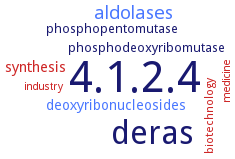4.1.2.4: deoxyribose-phosphate aldolase
This is an abbreviated version!
For detailed information about deoxyribose-phosphate aldolase, go to the full flat file.

Reaction
Synonyms
2-deoxy-D-ribose 5-phosphate aldolase, 2-deoxy-D-ribose-5-phosphate aldolase, 2-deoxyribose 5-phosphate aldolase, 2-Deoxyribose-5-phosphate aldolase, aldolase, deoxyribo, CGI-26, D-2-deoxyribose-5-phosphate aldolase, d5RP aldolase, DeoC, Deoxyriboaldolase, deoxyribose 5-phosphate aldolase, deoxyribose phosphate aldolase-like protein, Deoxyribose-5-phosphate aldolase, deoxyribose-phosphate aldolase, DERA, DPA, DR aldolase, Phosphodeoxyriboaldolase, TgDERA, TgDPA, Tk-DeoC, TK2104, TtDERA
ECTree
Advanced search results
Engineering
Engineering on EC 4.1.2.4 - deoxyribose-phosphate aldolase
Please wait a moment until all data is loaded. This message will disappear when all data is loaded.
D84G/DELTAY259
-
the catalytic activity towards 2-deoxy-D-ribose-5-phosphate cleavage is increased 4fold compared to the wild type enzyme
F200I
-
shows a nearly 14fold increase in productivity for (3R,5S)-6-chloro-2,4,6-trideoxyhexapyranoside formation
K13C
-
shows a slight increase in productivity for (3R,5S)-6-chloro-2,4,6-trideoxyhexapyranoside formation
M185T
-
shows a slight increase in productivity for (3R,5S)-6-chloro-2,4,6-trideoxyhexapyranoside formation
M185V
-
mutation results in an about 5fold increase in (3R,5S)-6-chloro-2,4,6-trideoxyhexapyranoside formation compared to the wild type enzyme
N80S/E127G/M185V/S258T/Y259T
-
contains an additional C-terminal KTQLSCTKW sequence, the catalytic activity towards 2-deoxy-D-ribose-5-phosphate cleavage is increased 2.5fold compared to the wild type enzyme
S238D
S238P
completely abolished catalytic activity in the retro-aldol reaction
S238P/S239P
completely abolished catalytic activity in the retro-aldol reaction
S239C
-
shows a slight increase in productivity for (3R,5S)-6-chloro-2,4,6-trideoxyhexapyranoside formation
S239P
the mutant enzyme increases the enthalpy change at the transition state, relative to the wild-type enzyme, but concomitant loss in entropy causes an overall relative loss in the TS free energy change. This entropy loss, as measured by the temperature dependence of catalysed rates, is mirrored in both a drastic loss in dynamics of the enzyme, which contributes to phosphate binding, as well as an overall loss in anti-correlated motions distributed over the entire protein
S93G/A174V
-
shows a nearly 3fold increase in productivity for (3R,5S)-6-chloro-2,4,6-trideoxyhexapyranoside formation
T19I/I166T
-
shows a slight increase in productivity for (3R,5S)-6-chloro-2,4,6-trideoxyhexapyranoside formation
T19S
-
shows a slight increase in productivity for (3R,5S)-6-chloro-2,4,6-trideoxyhexapyranoside formation
down
cells in which deoxyribose-phosphate aldolase expression is down-regulated using short hairpin RNA form fewer stress granules and are more prone to apoptosis after clotrimazole stress, suggesting the importance of deoxyribose-phosphate aldolase for stress granule formation
F165I
-
mutant enzyme shows 87.5 % of the activity of wild-type enzyme, preferable substrate tolerance compared with wild-type enzyme KDERA when the reactions are performed with 200 mM D-glyceraldehyde and acetaldehyde
F200I
-
2.4fold improvement in enzyme activities compared to wild-type enzyme, preferable substrate tolerance compared with wild-type enzyme KDERA when the reactions are performed with 200 mM D-glyceraldehyde and acetaldehyde
F200I/DELTAY259
-
substrate tolerance of the mutant enzyme is 37.3 % higher than that of wild-type enzyme
M185V
-
1.8fold improvement in enzyme activities compared to wild-type enzyme, preferable substrate tolerance compared with wild-type enzyme KDERA when the reactions are performed with 200 mM D-glyceraldehyde and acetaldehyde
S238D/F200I/DELTAY259
-
3.15fold improvement in enzyme activity and a 1.54fold increase in substrate tolerance towards D-glyceraldehyde compared with the wild type
C47A
the mutant enzyme is highly sensitive to crotonaldehyde and acetaldehyde
C47G
the mutant enzyme is highly sensitive to crotonaldehyde and acetaldehyde
C47L
the mutant enzyme shows no loss in stereoselectivity, the mutant is fully resistant to inhibition by crotonaldehyde
C47M
the mutant is both, the most acetaldehyde resistant variant and well performing on stereoselectivity, it is less resistant to crotonaldehyde than mutant C47M
C47S
although serine is similar to cysteine, this variant is ten times more stable against acetaldehyde than the wildtype
C47A
-
the mutant enzyme is highly sensitive to crotonaldehyde and acetaldehyde
-
C47G
-
the mutant enzyme is highly sensitive to crotonaldehyde and acetaldehyde
-
C47L
-
the mutant enzyme shows no loss in stereoselectivity, the mutant is fully resistant to inhibition by crotonaldehyde
-
C47M
-
the mutant is both, the most acetaldehyde resistant variant and well performing on stereoselectivity, it is less resistant to crotonaldehyde than mutant C47M
-
C47S
-
although serine is similar to cysteine, this variant is ten times more stable against acetaldehyde than the wildtype
-
S238D
-
mutant enzyme shows great improvement in catalytic activity towards sequential aldol reactions, mutant enzyme has wider specificity than wild-type enzyme, mutant enzyme shows activity with 3-azidopropionaldehyde and acetaldehyde, wild-type enzyme shows no activity


 results (
results ( results (
results ( top
top






